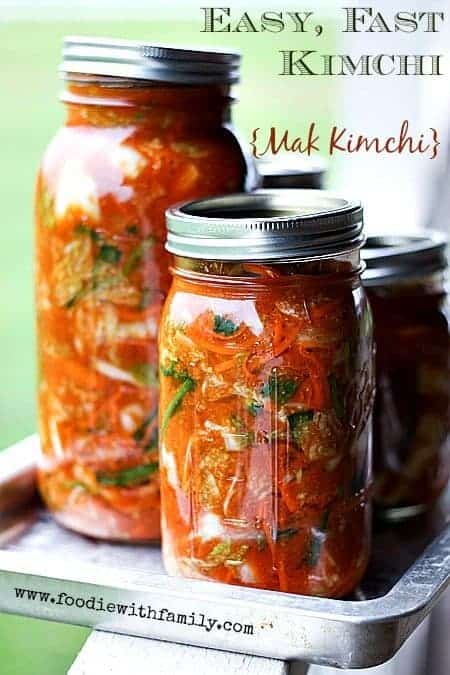
Love this Easy, Fast Mak Kimchi recipe? Check out our other fabulous Korean Food Recipes!
If you’ve been with me for a while, you’re well aware of my undying love for kimchi. Yes, it is stinky and bubbly and more than a little wild, but WOWZA the taste and the texture are so worth it.
If you’re new to the Foodie with Family family and you aren’t familiar with kimchi, I can give you a super condensed description; it’s essentially spicy, aromatic Korean sauerkraut. Today, I’m bringing you a fool-proof Easy Fast Kimchi recipe {Mak Kimchi}.
What is Kimchi?
Kimchi comes in almost as many forms as there are vegetables because nearly any vegetable can be fermented. They range from super mild smell to mega funky and mellow to melt-your-face-off spicy and there is one for every possible point in between.
The kimchi recipe that I’m sharing today is my family’s favourite version. It’s chock full of fabulous pro-biotics (as most kimchi is) and the longer it ages (translation: ferments) the stronger it becomes in both flavour AND pro-biotic content.
It’s like yogurt on steroids, people. That’s how good it is for you!
Is Kimchi Good For You?
Health Magazine named kimchi one of it’s Top 5 World’s Healthiest Foods. It is is low in calories and fat and high in dietary fiber and wicked high in Vitamins A, B, and C.
Many (if not most) Koreans eat a little kimchi with each meal or at least once a day. Kimchi is credited with helping most Koreans avoid obesity by virtue of its ability to satisfy even while being low calorie and low fat.
Seoul National University conducted a study and claimed that chickens infected with the H5N1 virus, also called avian flu, recovered after eating food containing the same cultured bacteria found in kimchi. That’s good enough for me!
How to Make Kimchi
Let’s get cracking and make some kimchi, shall we? The variety we’re making today is an Easy, Fast Kimchi recipe or Mak Kimchi…
In other words, it’s already cut up and ready to shovel into your mouth. Unlike what is usually just called ‘kimchi’ which is whole heads of napa cabbage smeared with the kimchi paste and allowed to ferment all wrapped up.
This version is FAR easier to make and far faster to be ready. Bonus, it is way easier to eat straight from the jar with a pair of chopsticks or a fork.
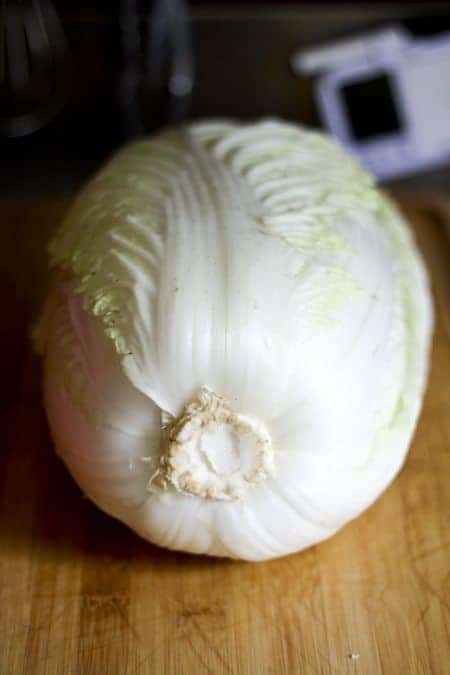
Do I need special tools to make kimchi?
In short, no. All you really need is a knife, a cutting board, and a big bowl. You will need a couple of ingredients that you may not have purchased before, but never fear, they’re not hard to find these days and I’ve included links to them below.
To begin with, you’ll need a big old head or two of Napa cabbage. I had two heads like the one above weighing in at about 3 pounds each.
It yielded, when all was said and done, about 3 quarts of kimchi, so that was perfect for me. You can cut that back if you think you can’t consume that amount of our Easy, Fast Kimchi recipe or Mak kimchi.
But I find all sorts of places to tuck it in, so it’s not an issue here and it’s only my husband, myself, and two of our boys who eat it. We love our kimchi.
Kimchi Recipe
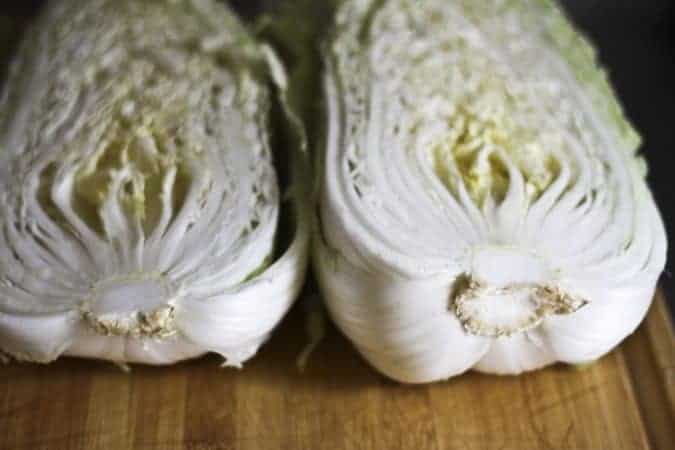
Lob your cabbages in half lengthwise. Use a paring knife to remove the gnarly core from them before cutting in half lengthwise again, leaving you with quarters.
Cut across the quarters to make bite-sized squares of cabbage. I usually shoot for 2-inch squares.
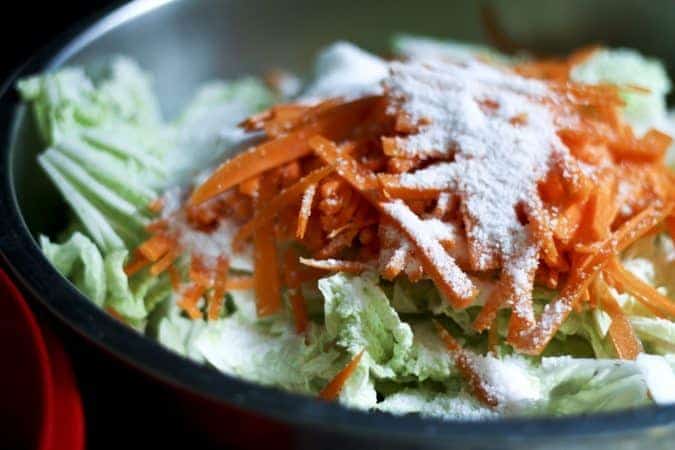
Add the cabbage to a monstrously huge bowl (or bowls), top with the julienned carrots, and sprinkle salt over the whole works. Toss the veggies and massage the mixture until the cabbage just starts to wilt.
Pour in enough cold water to over all the cabbage and carrots by a bit. It doesn’t have to be swimming in water, just covered.
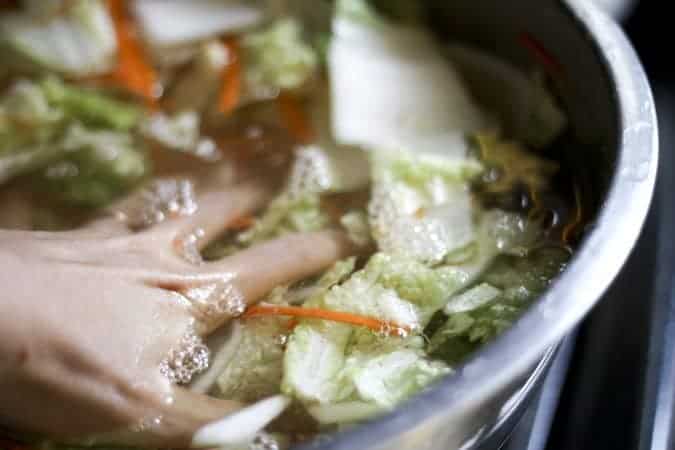
Stir it up with your hands and let it rest at room temp for a couple of hours.
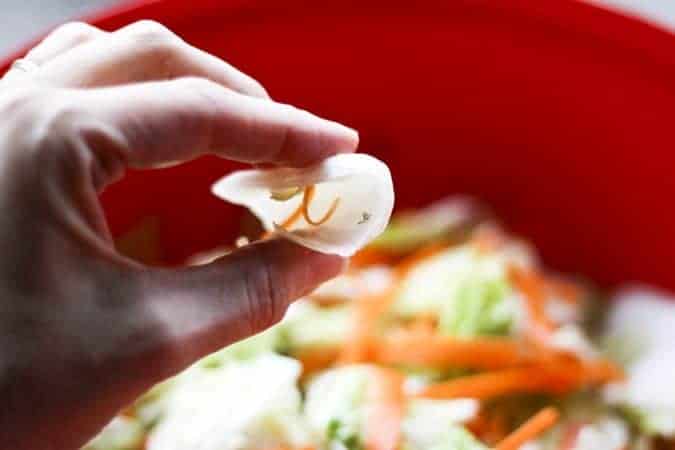
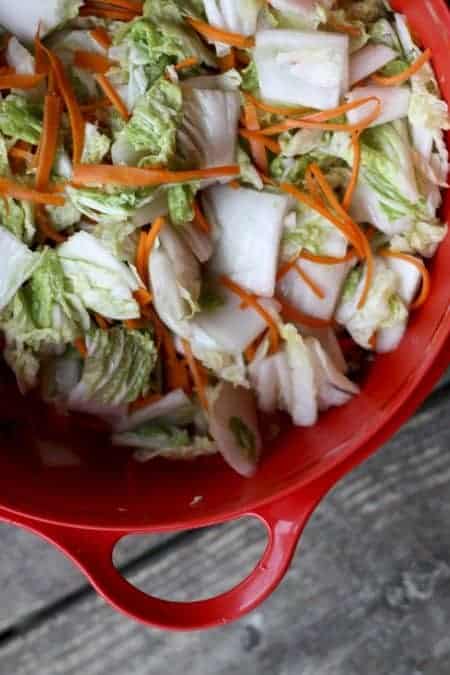
After a couple of hours, when the sturdier pieces of cabbage have become flexible, pour the whole lot into a strainer and let the brine water drain away.
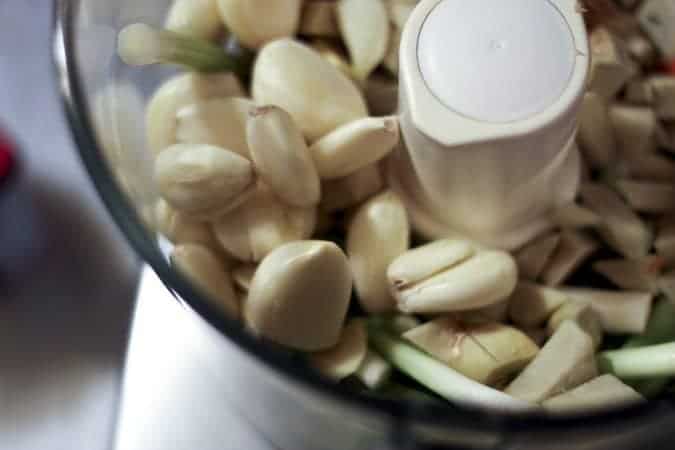
Now you’re going to whizz up the good stuff. Garlic, ginger, the white parts of scallions, Korean Red Pepper Powder*, fish sauce, unsweetened pear or apple juice, miso paste, and whatnot go into the food processor or blender.
Obliterate and smash it all into a lovely, red, fabulous smelling paste. It’s worth noting that you shouldn’t just up and increase the garlic because it can make kimchi linger more on your breath than you’d like it to do.
It also tastes out of balance if you add a lot more. Be aware.
And by the same token, you shouldn’t increase the ginger willy-nilly because that can make the final product a little more bitter than you’d like it to be. Start with the mixture and proportions I’m giving you and then play with it in subsequent batches.
*It’s important to note that you cannot use American or Mexican Chili Powder in place of the Korean pepper powder here. They’re COMPLETELY different animals. It may end up tasty, but I haven’t tested it so I cannot speak to it.
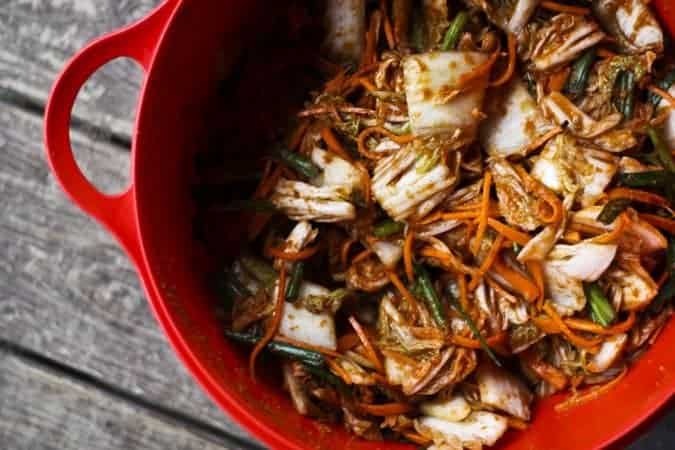
Now you’ll CRAM this stuff into jars or food-safe plastic containers. When I say cram it, I mean shove it in there as firmly as you can without putting your fist through the bottom of the jar.
I do prefer glass canning jars, if you’re wondering, because they don’t retain odors like plastic does, and, well, this stuff is odiferous! You can use a dedicated plastic kimchi bucket if you’d prefer, though.
Gently place a lid and ring on the jar, but don’t screw it tightly into place because BOOM. It’ll pop. This is active stuff, mes amies!
Place the jar on a rimmed pan or baking dish. The rim is pretty crucial here, because as the kimchi ferments at room temperature (and more slowly but still actively in the refrigerator) it will bubble up and may release a little juice over the edge of the jars.
In other words, you could have a kimchi river a-flowin’ on your counter top unless you take precautions. It’s easiest to use the pan and not worry about your Easy, Fast Kimchi recipe or Mak Kimchi bubbling over onto your counters.
It’s going to spend a couple of days at room temperature getting bubbly and fragrant. Every day, you’ll insert a clean chopstick or butter knife into the jar to help release air bubbles and top the jar off with extra brine if needed to keep everything submerged.
When it’s almost carbonated looking (usually between 24-72 hours after packing the jars), it’s ready to refrigerate. I highly recommend refrigerating it on the tray you used to contain the Grand Kimchi River while it fermented.
There aren’t a lot of things quite as unnecessary as removing everything from a fridge and mopping kimchi juices off of it. Take my word for it.
How long can I keep homemade kimchi?
It’s ready to eat at that point! Of course, it gets stronger and more kimchi-y the longer it sits. I love cooking with the older stuff and eating the newer stuff ‘raw’.
One of my all-time best-loved ways to eat older kimchi is in pancake form. Not like Aunt Jemima pancakes or flapjacks, but savoury, crispy-edged, kimchi-studded, pan-fried, snack cakes that convert even die-hard kimchi skeptics.
It’s the only way my eldest likes kimchi, but OH how he loves it this way. And the smell of kimchi pancakes while they cook is irresistible.
Bonus: This stuff lasts just about forever when you make sure the veggies are submerged in the brine. It’s hard to go wrong.
What can I make with my kimchi recipe? How do I use kimchi?
-Kimchi Fried Rice AND another version of Kimchi Fried Rice (the second one has a fried egg on top. SWOON!)
-Korean Army Stew- Budae Jjigae
-Kimchijeon (Savoury Kimchi Pancake)
Kimchi Ingredients
Kimchi
Cut the napa cabbage in half longways, then in half again longways. Cut the core out of the four quarters.
Cut the cabbage into squares (about 2-3 inches square), pop it in a bowl with the carrots. Sprinkle with the 1/2 cup kosher salt, massage so everything is coated in salt and starting to soften and wilt. Fill with cold, chlorine free water to cover it well and let it soak for at least 1 1/2 hours.
Pour the cabbage and carrots and liquid into a strainer. Let the brine drain away.
Lob off the white bits of the green onions and put them in a food processor with the garlic cloves, ginger, miso paste, and korean pepper powder. Zap it on high ’til it’s smooth-ish. Add in the fish sauce and a couple of slops of pear juice and zap it more until it’s about pancake batter consistency… maybe a bit thinner.
Put the brined cabbabe/carrots in a big, anti-reactive (glass, enamel, or stainless steel) bowl. Rough chop the green parts of the onions and add those to the cabbage/carrots. Pour the chili paste combo over the cabbage and wear gloves to massage it all over the cabbage/carrots green onions so everything is completely covered.
Pack super tight in canning jars. CRAM it in there.
Add a two-piece lid, but just set the ring in place to hold the lid down without screwing it in place. Place it on a rimmed baking dish to catch any spill-over.
Let it sit at room temperature for up to 72 hours, until it is bubbly and fragrant. Once every day, insert a clean chopstick or butter-knife to release air bubbles. If needed, pour in some additional brine to keep all the vegetables submerged.
Store on a rimmed sheet in the refrigerator for up to six months, being sure that the vegetables are submerged the whole time. The older it gets, the stronger it will become.
Notes
If you need extra brine to keep your vegetables submerged, please combine 1 quart of cool water with 4 teaspoons of kosher salt in a quart jar with a tight fitting lid and shake until the salt is dissolved. Use it to top off the vegetables as needed.
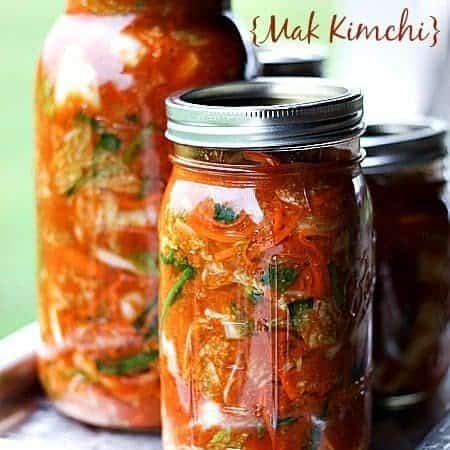
Easy, Fast Kimchi Recipe {Mak Kimchi}
Rate RecipeIngredients
- 3-8 pounds napa cabbage
- 2 bunches green onions trimmed of the root bits
- 2-3 large carrots peeled, thinly julienned
- 1/2 cup kosher salt
- 1/2 cup korean chili powder
- 15-20 cloves garlic overdoing garlic makes this stay on your breath more than usual., peeled
- 4-6 inches ginger peeled, rough chopped
- 1 tablespoon fish sauce
- unsweetened pear juice or unsweetened apple juice
- 4 tablespoons white miso paste
Instructions
- Cut the napa cabbage in half longways, then in half again longways. Cut the core out of the four quarters. Cut the cabbage into squares (about 2-3 inches square), pop it in a bowl with the carrots. Sprinkle with the 1/2 cup kosher salt, massage so everything is coated in salt and starting to soften and wilt. Fill with cold, chlorine free water to cover it well and let it soak for at least 1 1/2 hours.
- Pour the cabbage and carrots and liquid into a strainer. Let the brine drain away.
- Lob off the white bits of the green onions and put them in a food processor with the garlic cloves, ginger, miso paste, and korean pepper powder. Zap it on high ’til it’s smooth-ish. Add in the fish sauce and a couple of slops of pear juice and zap it more until it’s about pancake batter consistency… maybe a bit thinner.
- Put the brined cabbabe/carrots in a big, anti-reactive (glass, enamel, or stainless steel) bowl. Rough chop the green parts of the onions and add those to the cabbage/carrots. Pour the chili paste combo over the cabbage and wear gloves to massage it all over the cabbage/carrots green onions so everything is completely covered.
- Pack super tight in canning jars. CRAM it in there. Add a two-piece lid, but just set the ring in place to hold the lid down without screwing it in place. Place it on a rimmed baking dish to catch any spill-over. Let it sit at room temperature for up to 72 hours, until it is bubbly and fragrant. Once every day, insert a clean chopstick or butterknife to release air bubbles. If needed, pour in some additional brine to keep all the vegetables submerged.
- Store on a rimmed sheet in the refrigerator for up to six months, being sure that the vegetables are submerged the whole time. The older it gets, the stronger it will become.
Notes
Nutrition
Nutritional information is an estimate and provided to you as a courtesy. You should calculate the nutritional information with the actual ingredients used in your recipe using your preferred nutrition calculator.
did you make this recipe?
Make sure to tag @foodiewithfam on Instagram and #hashtag it #foodiewithfamily so I can check it out!
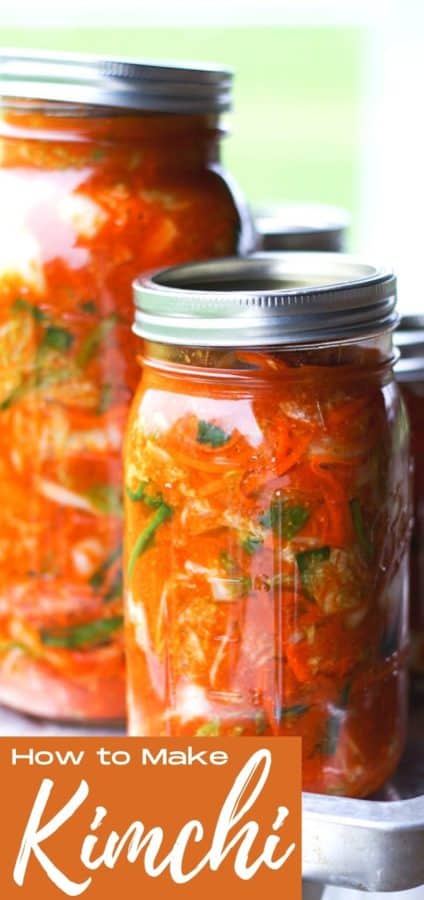
This post was originally published on December 2, 2013 and was updated December 28, 2016, June 2018, and September 2021.
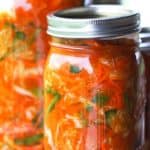



Reader's Thoughts...
Paddy Manning says
Kimichi is a health food if stomach cancer is healthy. Heavy kimichi users have a 50% raised stomach cancer rate.
Rebecca says
Okay, Paddy. You have some scientific backing for that? I mean double or triple blind studies? Otherwise, you’re just mad about a food that tastes good. 🙂
Amy says
Forgot to rate it…
Amy says
I’ve been making kimchi regularly for almost a year now, consulting different recipes. This recipe has become my gold standard, and the one I recommend to friends when they ask for ‘my’ recipe. It’s got a super flavor and is no-fuss, with good, non-dogmatic directions. I prefer it this way with the cabbage chopped – it makes it a lot easier to eat it straight out of the jar : ) And makes the recipe a lot faster (than rubbing the paste onto the leaves, traditional style). I do dump in a lot more fish sauce, and just a splash of juice (if I have it – if not I don’t add any). I find I always have plenty of liquid so I don’t need to make the paste consistency so thin. Also I don’t usually have miso lying around, and the recipe works okay without it. A word on fermentation – in the summer the jar is ready to pop after one night, while in the winter it takes a few days for the fermentation to really begin. Oh, and I’ve made kimchi with regular cabbage, and for me it just lacks that kimchi flavor. I don’t know why that is, but my two cents’ is to definitely stick with using Napa cabbage. Anyway, thank you for posting this recipe!
Nancy says
Room temperature here in Texas can be 77 degrees is that ok?
yasmine says
This looks lovely. I want to try this over the next few days. Can I substitute miso paste with something else?
Thanks
Yasmine
Rebecca says
Hi Yasmine- If you’d like, you can omit the miso entirely. I think it adds a nice umami touch to the final kimchi, though. 🙂
nicole says
can you use ACV instead of unsweetened apple juice?
Rebecca says
Hi Nicole! I’m not sure I would do that. You can omit the apple juice with good results, but I don’t think I’d add vinegar. 🙂
Petra Hennig says
Thanks for the recipe!
How can I make additional brine?Just salted water?
Rebecca says
You’re very welcome, Petra. I don’t remember the exact proportions right at the moment, but I know I’ve mentioned it a few times here in the comments section. If you wouldn’t mind scrolling through the comments a bit, I’m sure it’s in there! 🙂
vincent c pitt says
I have never made Kimchi , Your recipe looks SOOO GREAT that I,m going to try it.
Thank you for your BEAUTIFUL pages on this WEB sight.
Cate says
Hi there,
Thanks so much for this recipe- we love kimchi!! I accidentally subbed out cayenne and it’s spicier than intended, but that’s ok (I was winging it and using what I had on hand!). The smell and the flavour are wonderful. We made it over a week ago, and it was on the counter for 3 days and then we put it in the fridge.
My question is, when I took it out yesterday, it doesn’t seem very liquidy, much more like a paste. Is this normal? Maybe it just needs to ferment more to let off more liquid? We had a nice little river in our pan so it was definitely doing it’s thing, I’m just concerned that it’s a bit gloopy now. Has this happened to you before?
Thanks!
Rebecca says
Whooooooeeee, Cate! That’s got to be wicked hot if you used cayenne in equal parts. 🙂 Give your kimchi a stir and see whether that gloopiness evens out. I’m not sure whether it has anything to do with the different type of pepper powder you used or whether it’s just a dry weather issue.
Brandon says
I am looking forward to making this but I have a couple of questions.
1. Should I save the initial brine from step 2 in case I need to add more in those first 72 hours?
2. Is the chili paste combo wet enough to keep the cabbage submerged?
Rebecca says
Hi Brandon- I’d recommend mixing up a fresh brine to add if you need it and the chili paste combo will not be wet enough at first, but the cabbage will create its own liquids as it gets happy in the paste. If there isn’t enough liquid to submerge it after about 6 hours at room temp, please add some brine to top it off.
Brandon says
thank you! Excited to try it!
Tracy says
Can’t wait to try this. Looks easy and I do love Kimchi anytime
ella says
Ironically, a forkful of this kimchi every day has allowed me to stop taking IBS medication been on for years with sketchy results. Probiotics did nothing. Doc is stunned. I love this stuff anyway, go figure… just made another batch, waiting for the great kimchi river… again…
Rebecca says
Nice, Ella! I’m so glad you love it and it helps you!
Jan says
Can I use red or yellow cooking onion instead of green?
Rebecca says
Hi Jan- I have never tried that. I suspect they would work but will likely be a much more powerful oniony taste than the green onions. Please let me know how it works out for you if you try it!
Sheetal kapoor says
I think this is gonna be delicious. Thanks for the recipe, Rebecca.
Regards
Tngirl05 says
I made this yesterday morning, and we had a taste of it with dinner this evening. It is already SO good. We don’t go through a ton of kimchi usually, so I only made 1/3 of the recipe and got a good quart out of it. I didn’t have any miso paste or juice, and it is still incredible.
This will definitely be my go to kimchi recipe from now on. Much easier than another I’ve tried and super tasty.
Rebecca says
Thanks so much, Tngirl05, for taking the time to let me know you loved it and rate the recipe!
Meg says
Hello!
I was wondering, would it matter if I cut the cabbage into smaller pieces? So it was more shredded?
Rebecca says
Hi Meg- I’m not sure, as I haven’t tried that! It might work. 🙂
Kent Barnes says
That is 3.2 grams net carbs in 1/32 of recipe equals a serving
Ken Walsh says
Can you use red miso?
Rebecca says
Hey Ken! It’ll be slightly stronger tasting, but I don’t see any reason why you can’t!
Terri Sevilla says
Hi. I can’t wait to make this mak kimchi!
The photos show dark green veggie pieces, (green onion?) May I add to cabbage/carrot mixture?
Thank you for your help.
Rebecca says
Absolutely, Terri! I hope you enjoy it!
Sunni says
Hello, this looks like a wonderful recipe I cannot wait to try. Just a quick question about nutritional info and the super high sodium content. Where is that coming from? It says one serving is 79%daily intake! Is that from the fish sauce? Can I substitute something like a low sodium soy? Thanks for your time.
Sunni says
Sorry somehow missed the 1/2 cup of salt in the recipe! I am new to the making of kim chi, is this always the case? Seems to defeat the purpose of being healthy with this much sodium.
Rebecca says
Hi Sunni- Please note that this is not the total amount of sodium that ends in the final product. You are creating a brine with the water and salt, soaking the vegetables to break down the cell walls, then draining off the salt water brine. To be sure, some salt is in there, but the vast majority of it drains away before the pepper paste is added. I wouldn’t worry!
Rebecca says
In answer to this, it is because I use an automatic nutrition calculator and it does not take into account the salt water brine that is drained off when calculating the nutritionals. I’m not sure what the final sodium count is, but it is VASTLY lower than that.